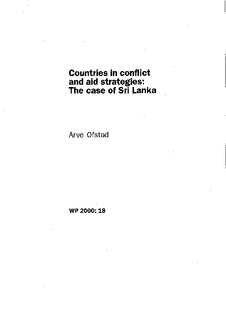Countries in violent conflict and aid strategies: The case of Sri Lanka
| dc.contributor.author | Ofstad, Arve | |
| dc.date.accessioned | 2008-02-28T07:29:06Z | |
| dc.date.accessioned | 2017-03-29T09:12:08Z | |
| dc.date.available | 2008-02-28T07:29:06Z | |
| dc.date.available | 2017-03-29T09:12:08Z | |
| dc.date.issued | 2000 | |
| dc.identifier.isbn | 82-90584-79-2 | |
| dc.identifier.issn | 0804-3639 | |
| dc.identifier.uri | http://hdl.handle.net/11250/2435754 | |
| dc.description.abstract | In countries with an ongoing violent conflict aid donors are confronted by four sets of issues: How the volume and orientation of the program may influence a peace process; whether development efforts may be undertaken in rebel controlled territories; and how an early rehabilitation program may affect the long term process. In this article we analyze the strategies applied in Sri Lanka by donors applying a traditional development approach and those following a more comprehensive approach. Dilemmas are created vis-à-vis both the governments and the rebels' policies and interests. Four general conclusions underline the political nature of development aid programs during a violent conflict. | |
| dc.language.iso | eng | |
| dc.publisher | Chr. Michelsen Institute | |
| dc.relation.ispartofseries | CMI Working paper | |
| dc.relation.ispartofseries | WP 2000: 18 | |
| dc.subject | Aid policy | |
| dc.subject | Conflicts | |
| dc.subject | Rehabilitation | |
| dc.subject | Sri Lanka | |
| dc.title | Countries in violent conflict and aid strategies: The case of Sri Lanka | |
| dc.type | Working paper |
Tilhørende fil(er)
Denne innførselen finnes i følgende samling(er)
-
Bora-import [434]
